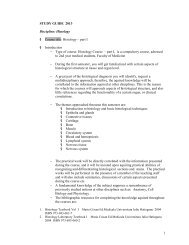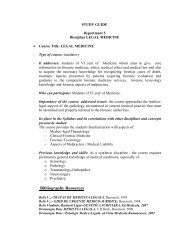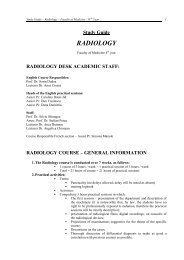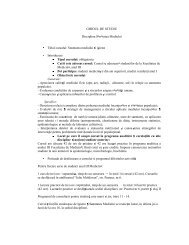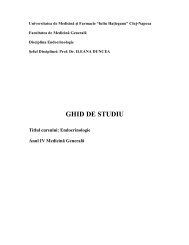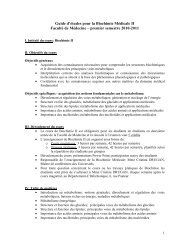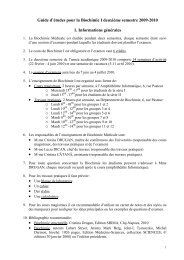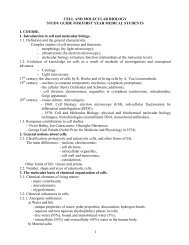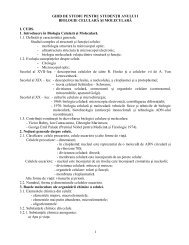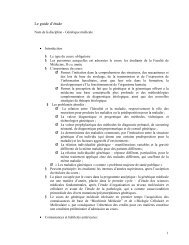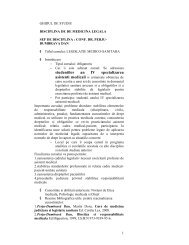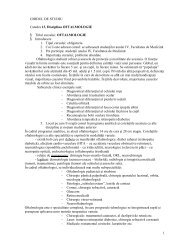Title: MICROBIOLOGY - UMF - Iuliu Haţieganu
Title: MICROBIOLOGY - UMF - Iuliu Haţieganu
Title: MICROBIOLOGY - UMF - Iuliu Haţieganu
Create successful ePaper yourself
Turn your PDF publications into a flip-book with our unique Google optimized e-Paper software.
STUDY GUIDE 2009-2010<br />
<strong>MICROBIOLOGY</strong> DEPARTMENT<br />
III-rd YEAR COURSE<br />
COURSE TITLE: CLINICAL <strong>MICROBIOLOGY</strong><br />
Introduction<br />
Course type: compulsory<br />
To whom is the course addressed: General Medicine students: third year<br />
Course importance<br />
- Revealing the bacteria, protozoa, helminthes and fungi importance as etiologic agents of<br />
different infectious clinical entities (respiratory tract infections, CNS infections (meningitis,<br />
encephalitis) and the diarrhea syndrome<br />
- Learning the medical notions, concerning pathogenesis and laboratory diagnosis of bacterial,<br />
parasitic and fungal infections, in order to understand their role in the human pathology.<br />
Place of the discipline in the curricula: preclinical disciplines; correlation with clinic<br />
disciplines: infectious diseases, immunopathology<br />
Anterior knowledge and abilities: Fundamental Microbiology<br />
Course and laboratories program: on university site:<br />
Hours/week: Courses: 2, Practical activities: 2,<br />
Hours/semester: Course: 28, Practical activities: 28<br />
General goals: Medical Bacteriology, Parasitology and Mycology<br />
Specific goals:<br />
- Knowledge of genres and species proprieties, pathogenity factors, of pathogenesis and<br />
laboratory diagnosis of bacterial, parasitic and fungal infections.<br />
- Knowledge of methods and techniques used for the microorganism’s detection and<br />
identification.<br />
Content: Clinical Microbiology: course and laboratory<br />
• Evaluation<br />
Written final exam consisting of multiple choice tests and written subjects (70%)<br />
1
Verifications tests during the year through oral/written and examination for laboratories +<br />
practical exam (30%)<br />
Examination mode: Written final exam consisting of 40 multiple choice questions (second year)<br />
and 30 multiple choice questions (third year)<br />
Marking mode:<br />
-Written final exam 70%<br />
-Verifications tests during the year through oral/written and examination for laboratories +<br />
Practical exam - 30 % ( bonus will be offer for students which made presentations - see<br />
facultative activities)<br />
Condition for passing the exam: mark 5<br />
Calendar of the exam: established together with the course titular, during winter session and<br />
summer session.<br />
Course titular: Prof. Dr. Lia Monica Junie<br />
Consultation schedule:<br />
Prof. Dr. Lia Monica Junie<br />
Thursday 13 - 15<br />
Educational objectives:<br />
What students have to know:<br />
1. Knowledge of methods and techniques used for the detection and identification of<br />
microorganisms.<br />
2. Knowledge of principles and interpretation of microbiologic diagnosis procedures results.<br />
What students have to do?<br />
1. Enabling students to perform some diagnostic laboratory techniques, witches are necessary for<br />
a practitioner doctor.<br />
2. Interpretation the microbiology laboratory data.<br />
Facultative activities<br />
Preparation and presentation of reviews about a subject of choice in front of colleagues<br />
2
Course content: CLINICAL <strong>MICROBIOLOGY</strong><br />
Respiratory tract infection<br />
Upper respiratory tract infections<br />
Bacterial Angina (Pharyngitis) and laryngitis<br />
-Corynebacterium diphteriae<br />
-Streptococcus pyogenes group A<br />
Bacterial Pyogenic Infections<br />
Lower respiratory tract infections<br />
Acute bronchitis & Pneumonia<br />
Bacterial Pneumonia<br />
Atypical pneumonia<br />
Fungal Pneumonia<br />
Fungal Infections of the CNS (meningitis)<br />
Fungal Generalized infections<br />
Central nervous syndrome infections<br />
Bacterial Infections of the CNS<br />
(meningitis); Bacterial toxins with neural<br />
tropism<br />
Parasitic Infections of the CNS<br />
Encephalitis produced by parasites<br />
Blood Protozoa<br />
Congenital infections<br />
Sexually transmitted infections<br />
- Staphylococcus aureus, Genus Staphylococcus<br />
-Streptococcus pneumoniae; Genus Streptococcus<br />
-Bordetella pertusis<br />
-Chlamydia, Mycoplasma pneumoniae<br />
-Legionella pneumophila, -Coxiella burneti<br />
- Pneumocystis jiroveci<br />
- Aspergillus,<br />
- Criptococcus neoformans,<br />
- Candida,<br />
Bacterial Infections of the CNS<br />
-Haemophylus influenzae,<br />
-Neisseria meningitidis<br />
- Clostridium tetani, botulini - tetanus, botulism<br />
-Free living amoeba: Naegleria, Acanthamoeba<br />
-Cerebral malaria,<br />
-Cerebral toxoplasmosis<br />
- Plasmodium<br />
-Toxoplasma<br />
vaginitis: Candida and Trichomonas<br />
- Trichomonas vaginalis<br />
Digestive tract infections produced by<br />
Protozoa<br />
- Entamoeba,<br />
- Giardia,<br />
- Cryptosporidium,<br />
- Microsporidium<br />
3
Table of Contents<br />
COURSE TITLE: CLINICAL <strong>MICROBIOLOGY</strong>.................................................................. 1<br />
RESPIRATORY TRACT INFECTIONS................................................................................... 6<br />
UPPER RESPIRATORY TRACT INFECTIONS................................................................. 7<br />
BACTERIAL ANGINA ........................................................................................................ 7<br />
Corynebacterium diphtheriae - Pharyngeal diphtheria........................................................ 7<br />
Streptococcus pyogenes - Angina (strep throat) .................................................................. 8<br />
LOWER RESPIRATORY TRACT INFECTIONS............................................................. 10<br />
PNEUMONIA ....................................................................................................................... 10<br />
Streptococcus pneumoniae - lobar pneumonia .................................................................. 10<br />
Streptococci belonging to normal flora.............................................................................. 11<br />
Viridans streptococci, the C, D group streptococci, the enterococci................................. 11<br />
Bordetella pertussis, Mycoplasma pneumoniae, Chlamydia psittaci ................................ 12<br />
Staphylococcus aureus - genre Staphylococcus................................................................. 14<br />
CNS INFECTIONS................................................................................................................. 16<br />
BACTERIAL MENINGITIS ............................................................................................. 16<br />
Haemophilus influenzae..................................................................................................... 16<br />
Neisseria meningitidis (meningococcus) ........................................................................... 17<br />
Clostridium botulinum, Clostridium tetani........................................................................ 17<br />
SEXUALLY TRANSMITTED DISEASES.......................................................................... 20<br />
Neisseria gonorrhoeae - Gonorrhea .................................................................................. 20<br />
FUNGAL INFECTIONS ........................................................................................................ 21<br />
Pneumocistis jirovecii- (former carinii) - Pneumocystis pneumonia, pneumocistosis...... 21<br />
Aspergillus - pulmonary aspergillosis................................................................................ 22<br />
Cryptococcus neoformans- Pulmonary cryptococcosis..................................................... 23<br />
4
Candida species.................................................................................................................. 24<br />
PARASITOLOGY - PROTOZOA............................................................................................ 27<br />
SEXUALLY TRANSMITTED DISEASES.......................................................................... 27<br />
Trichomonas vaginalis....................................................................................................... 27<br />
DIGESTIVE TRACT INFECTIONS.................................................................................... 28<br />
Entamoeba hystolitica........................................................................................................ 29<br />
Giardia lamblia intestinalis: Giardiasis............................................................................. 29<br />
Cryptosporidium – cryptosporidiosis, cryptosporidium enteritis ...................................... 30<br />
Microsporidia - microsporidiasis ....................................................................................... 31<br />
INFECTIONS OF THE CNS................................................................................................. 32<br />
Free living amoebae............................................................................................................... 33<br />
Toxoplasma gondii............................................................................................................. 34<br />
Plasmodium - malaria ........................................................................................................ 35<br />
Bibliography:<br />
1. Junie Monica, Stanila Luciana, Carmen Costache (2003),”Medical Microbiology:<br />
Bacteriology, Virology, Infection and Immunity”, “<strong>Iuliu</strong> Hatieganu” Publishing House, Cluj-<br />
Napoca, Romania, ISBN<br />
2. Stanila Luciana, Junie Monica, ”General Bacteriology and Virology” (2001) “<strong>Iuliu</strong> Hatiegenu”<br />
Publishing House, Cluj-Napoca, Romania, ISBN<br />
3. George F. Brooks, Janet S. Butel, Stephen A. Morse, Joseph L. Melnick, Ernest Jawetz,<br />
Edward A. Adelberg- Jawetz, Melnik Adelberg’s Medical Microbiology – 24-th edition,<br />
McGraw-Hill Professional Ed., 2004, ISBN 0071412077, 9780071412070<br />
4. Medical Parasitology – Markell, Voge, John, 9-th edition, 2006<br />
5. Diagnostic Medical Parasitology - Lynne Shore Garcia, 5th Edition, ASM Press, 2006<br />
6. www.dpd.cdc.gov/dpdx<br />
5
RESPIRATORY TRACT INFECTIONS<br />
Educational Objectives:<br />
Respiratory tract infections: etiology, pathogenesis, laboratory diagnosis<br />
I. Upper respiratory tract infections<br />
Bacterial angina<br />
1. Corynebacterium diphtheriae - Pharyngeal diphtheria,<br />
2. Streptococcus pyogenes - Streptococcal angina<br />
II. Lower respiratory tract infections<br />
Bacterial pneumonia:<br />
1) Streptococcus pneumoniae - lobar pneumonia<br />
2) Bordetella pertussis - whooping cough,<br />
4) Chlamydia psittaci, pneumoniae<br />
5) Mycoplasma pneumoniae - atypical interstitial pneumonia<br />
Table of Contents<br />
1. Corynebacterium diphtheriae:<br />
2. Streptococcus pyogenes: Streptococcal angina, other pyogenic infections<br />
3. Staphylococcus aureus - pyogenic infections and other infections<br />
4. Streptococcus pneumoniae; lobar pneumonia,<br />
5. Streptococci belonging to normal flora (commensally) => opportunistic pathogen<br />
6. Bordetella pertussis: whooping cough,<br />
7. Chlamydia psittaci, pneumoniae,<br />
8. Mycoplasma pneumoniae- Atypical interstitial pneumonia<br />
Algorithm<br />
- general properties, morphology,<br />
- species, classification,<br />
- transmission<br />
- virulence factors<br />
- pathogenesis<br />
- immunity<br />
- clinic: signs and symptoms<br />
- treatment: susceptibility/ resistance to antibiotics drugs<br />
- prevention: vaccin<br />
6
UPPER RESPIRATORY TRACT INFECTIONS<br />
BACTERIAL ANGINA<br />
Corynebacterium diphtheriae - Pharyngeal diphtheria<br />
Corynebacterium Genre: species, infections C. diphtheriae is a pathogenic bacterium that causes<br />
diphtheria. It is also known as the Klebs-Löffler bacillus,<br />
Essential: C. diphtheriae: general properties, morphology, classification, subspecies: C.<br />
diphtheriae mitischodis, C. diphtheriae intermedius, C. diphtheriae gravis, C. diphtheriae<br />
belfanti, transmission (infected persons, carriers), toxigenic and non-toxigenic strains.<br />
Diphtheria toxin (exotoxin): general properties, molecular mechanism of action: stages,<br />
consequences on eukaryotic cells. Structure correlated with the functions of fragments: B, A, T;<br />
The toxin in the bloodstream, the effect on different cells and on different organs: cardiotoxic<br />
and neurotoxic effects. Toxin production: strains, lysogenic conversion, non- lysogenised<br />
strains: significance. Factors influencing the secretion of toxin: the iron concentration.<br />
Diphtheria Antitoxin: definition, effect on toxin, practical application. Toxoid and<br />
immunization: DTaP (diphtheria-tetanus-pertussis), Td (tetanus-diphtheria toxoid):<br />
definition, properties, application and results.<br />
Important: Diphtheria: Pathogenesis: adherence, penetration and multiplication, consequences<br />
on pharyngeal mucosa: the throat membrane. The effect of diphtheria toxin in human body:<br />
local (mucosal damage) and general phenomena of infection. Immunity: antibodies, antitoxic<br />
serum and protective level: definition, effect on the toxin in blood and in cells, practical<br />
application. Serum therapy: definition, application, result. Diphtheria immunity testing: The<br />
Schick test: purpose, procedure type, aspect of the skin around the injection, interpretation,<br />
Positive, Negative reaction. Laryngeal diphtheria (diphtheritic croup): pathogenesis<br />
(inflammation of the larynx, and respiratory obstruction), risk groups, consequences,<br />
supportive care. Cutaneous diphtheria. Sensitivity to antibiotics of C. diphtheriae<br />
Laboratory diagnosis of diphtheria: at practical activity.<br />
Useful: The signs and symptoms of diphtheria.<br />
Genus Corynebacterium: general properties, species, habitat, risk factors for infections,<br />
infections, practical applications.<br />
Optional: differential diagnosis with other types of angina (e.g. strep throat).<br />
Questions and reviewing<br />
1. Diphtheria toxin is produced only by those strains of C. diphtheriae that are:<br />
a. Glucose fermenters<br />
b. Sucrose fermenters<br />
7
c. Lysogenized with - β tox. prophage<br />
d. of the Mitis strain<br />
e. Encapsulated strain<br />
2. Which of the following diseases can be prevented by vaccination?<br />
a. whooping cough<br />
b. tetanus<br />
c. diphtheria<br />
d. erysipelas<br />
e. gas gangrene<br />
Essential:<br />
Streptococcus pyogenes - Angina (strep throat)<br />
Streptococcus pyogenes: Group A β-hemolytic streptococcus (abbreviated GAS or GABHS):<br />
general properties, classification, group, serotypes.<br />
Virulence factors: Streptococcal Surface factors (M protein, fibronectin-binding protein<br />
(Protein F) and lipoteichoic acid for; hyaluronic acid capsule), non-toxic extracellular factors,<br />
hemolysins, streptolysine S and O, streptokinase, hyaluronidase, streptodornase, C5a peptidase,<br />
chemokine protease), Exotoxins, Streptococcal pyrogenic exotoxin A: properties, target of<br />
action, mechanism of action, effect on cells (leukocytes, red blood cells) and tissues of the<br />
human body; role in producing infection (e.g. adherence, dissemination factors), immunogenicity<br />
(antigen, superantigen, induced specific antibodies, neutralizing antibodies, protective<br />
immunity), importance in diagnostic.<br />
Angina-Pharyngitis ("strep throat"): transmission, carriers, pathogenesis, streptococcal<br />
serotypes involved, immunity and specific antibodies: anti-streptococcal antibodies, antistreptolysine<br />
O antibodies-AS(L)O: effect on human structures, method: importance and<br />
interpretation. Complications: Suppurative (pyogenic) and non-suppurative (non-pyogenic).<br />
Scarlet fever: strains, streptococcal serotypes involved, pathogenesis: Erythrogenic toxin - Dick<br />
toxin: production, antigenic types, role. Immunity in scarlet fever: Dick test: local reaction,<br />
interpretation.<br />
Poststreptococcal "non-pyogenic" syndromes, that occur after infection with Group A<br />
streptococci: rheumatic fever; acute glomerulonephritis: streptococcal serotypes involved,<br />
pathogenesis, prevention.<br />
Laboratory diagnosis of strep throat: at practical activity.<br />
Important: Other infections caused by Streptococcus pyogenes: Pyogenic infections: Skin<br />
diseases: Impetigo, Ecthyma, Cellulitis, Erysipelas, Necrotising fasciitis, Invasive streptococcal<br />
infections: Puerperal Fever, streptococcal toxic shock syndrome.<br />
8
Useful: Streptococcal pharyngitis: geographical, seasonal, age group distribution, clinical<br />
evolution and treatment.<br />
Optional: Other hemolytic streptococci, group B streptococci: habitat and human infections<br />
(neonatal infections, postpartum septicemia, bacteriemia, pneumonia, and urinary infections),<br />
treatment and prevention.<br />
Questions and reviewing<br />
1. Pharyngitis can be produce by:<br />
a. Clostridium tetani<br />
b. Klebsiella pneumoniae<br />
c. Herpes simplex virus 1 (HSV-1)<br />
d. Streptococcus pyogenes<br />
e. Corynebacterium diphteriae<br />
2. Scarlet fever is produce by the exotoxin of:<br />
a. Staphylococcus aureus<br />
b. Corynebacterium diphteriae<br />
c. Haemophilus influenzae<br />
d. Streptococcus pneumoniae<br />
e. Streptococcus pyogenes<br />
3. Group A β-hemolytic streptococcus:<br />
a. is also known as GAS<br />
b. is also known as Streptococcus pyogenes<br />
c. produces rheumatic fever<br />
d. produces acute glomerulonephritis<br />
e. produces diphtheria.<br />
9
LOWER RESPIRATORY TRACT INFECTIONS<br />
PNEUMONIA<br />
Algorithm<br />
- general properties, morphology,<br />
- species, classification,<br />
- transmission<br />
- virulence factors<br />
- pathogenesis<br />
- immunity<br />
- clinic: signs and symptoms<br />
- treatment: susceptibility/ resistance to antibiotics drugs<br />
- prevention: vaccine<br />
Streptococcus pneumoniae - lobar pneumonia<br />
Essential: Streptococcus pneumoniae -Pneumococci: properties, habitat, transmission, access to<br />
the lung, location, infections. Virulence factors: on pneumococci surface (polysaccharide<br />
capsule, pili, pneumococcal surface proteins: pneumococcal surface adhesin A (PsaA), protective<br />
antigen (PspA), choline binding protein A-CbpA, M protein, cell wall components), intracellular<br />
toxins (autolysins (LytA, LytB, LytC), pneumolysin-Ply, hydrogen peroxide, nitric oxide),<br />
extracellular non-toxic compounds (IgA1 protease, neuraminidase, hemolysins, hyaluronidase,<br />
serine protease): production, chemical composition, mechanism of action, role in the<br />
pathogenesis of pneumococcal infection, effect on bacterial cells, red blood cells, lymphocytes,<br />
phagocytes (anti-phagocytic, opsonization, antiopsonizing), on bronchial epithelium on secretory<br />
IgA and inflammatory cascades (cytokines, complement system); inflammatory effect (purulent<br />
or suppurative exudate), type-specific pneumococcal antigens, immunogenicity: effect of<br />
induced antibodies (induction of neutralizing, protective, and opsonizing antibodies, typespecific<br />
protective antibodies), immunological memory, immunological immaturity in children ≤<br />
2 year.<br />
The pathogenesis of pneumococcal infection: in the lung (attachment to respiratory mucosa, to<br />
the epithelium, colonization of pharyngeal and bronchial mucosa, penetration of pneumococci to<br />
the alveoli) and extra pulmonary (systemic invasion, bacteriemia, meningitis).<br />
Laboratory diagnosis of pneumococcal infections, Laboratory diagnosis of pneumonia: at<br />
practical activity.<br />
Important: Pathogenesis of pneumonia: is a complex interplay between pneumococcal<br />
virulence determinants and the host immune response. Pneumococcal adherence to human<br />
epithelial oropharyngeal cells, colonization of the nasopharynx mucosal epithelium, penetration<br />
of endothelial mucosa, bacteria in the alveolar space, adherence on alveolar cells type II,<br />
10
multiplication in the alveolar space, cytotoxic effects on pulmonary cells and pulmonary<br />
inflammation. The molecular events in pneumococcal inflammation; the mechanism of the<br />
inflammatory response in the lung (inflammatory exudate): serous exudate and purulent exudate<br />
in alveoli. Pathogenesis of meningitis: pneumococcus adherence to brain capillaries (choline,<br />
CbpA, cell receptors), inflammatory response.<br />
Useful: Pneumococcal Pneumonia (Lobar Pneumonia): incidence, pneumococcal types,<br />
transmission, contributing factors, risk groups, complications, mortality.<br />
Hospital-acquired infections: Antibiotic resistant strains and antibiotic susceptibility testing.<br />
Antibiotic therapy recommended for infections caused by resistant strains.<br />
Pneumococcal meningitis: particularities.<br />
Optional: Pneumococcal capsular polysaccharides, serotypes; vaccine: composition, type of<br />
vaccine, immunogenicity and protection.<br />
Streptococci belonging to normal flora<br />
Viridans streptococci, the C, D group streptococci, the enterococci<br />
Essential: habitat, species, human infections, pathogenesis.<br />
a) Viridans streptococci: habitat (commensally bacteria, opportunistic pathogen bacteria),<br />
properties (lack either the polysaccharide-based capsule typical of S. pneumoniae or the<br />
Lancefield antigens of the pyogenic members of the genus, optochin resistant), human infections:<br />
Subacute bacterial endocarditis: mechanism of production: dental extractions, bacteria into the<br />
bloodstream, multiplication of the streptococci on damaged heart valves by rheumatic lesions,<br />
congenital heart disease; S. mutans: Role in tooth decay (adhesion to the surface of teeth, dental<br />
plaque, dental caries).<br />
b) Enterococci: habitat (normal flora of the bowel, mouth), human infections: hospital<br />
opportunistic infections, urinary infections, subacute bacterial endocarditis.<br />
c) Group C, D streptococci: human infections.<br />
Important: Streptococcus Genre: General properties, Classification. Peptostreptococcus -<br />
anaerobic streptococci. Laboratory diagnosis of infections produced by: viridans streptococci,<br />
group B streptococci, enterococci (at practical activity)<br />
Useful: Streptococcaceae family: general properties, pathogenic genera for humans<br />
(Streptococcus, Enterococcus), commensal species of upper respiratory tract, rarely pathogenic<br />
species for humans.<br />
Optional: non-pathogenic species for humans: bacteria present in the air, on fruits, vegetables<br />
(saprophytes of plants), bacteria present in milk and cheese (Lactococcus), Lactobacillus,<br />
Leuconostoc, Pediococcus, nutritional "deficiencies"variants (Abiotrophia) .<br />
11
Bordetella pertussis, Mycoplasma pneumoniae, Chlamydia psittaci<br />
Essential: Bordetella pertussis: the causative agent of pertussis or whooping cough; general<br />
properties, pathogenic factors (adhesion factors, toxins: filamentous hemagglutinin, pertussis<br />
toxin (PTx), adenylate cyclase (CyaA)), mechanism of action, pathogenesis of whooping cough<br />
(colonization stage = upper respiratory disease, toxemic stage), immunization: Pertussis vaccine,<br />
DTaP.<br />
-Mycoplasma pneumoniae: major pathogen, general properties, transmission (by respiratory<br />
droplets), distribution: worldwide, group risk (young adults), pathogen only for humans, the<br />
causative agent of human primary atypical pneumonia (PAP) or walking pneumonia:<br />
outbreaks in groups with close contacts: families, college students, increase incidence in winter.<br />
Treatment: Tetracycline, Erythromycin.<br />
-Chlamydia pneumonia: human upper respiratory infections, atypical pneumonia: general<br />
properties, transmission.<br />
-Chlamydia psittaci: general properties, reservoir normal hosts (birds, parrots and pigeons,),<br />
human contamination (avian excreta, respiratory way, and respiratory secretions), psittacosis<br />
(ornithosis or parrot fever), pathogenesis of human lung infection: primary atypical<br />
pneumonia. (C psittaci attaches to the respiratory epithelial cells, spreads via the blood stream<br />
(bacteremia) to the reticuloendothelial system (systemic disease), lung infection. Prophylaxis:<br />
restricting the contact with birds (parrots), adding tetracycline to bird feed, flocks of turkeys and<br />
ducks surveyed. Treatment: Tetracycline, Doxycicline, Azytromycin.<br />
Important: Genus Bordetella: species, infections. Genus Mycoplasma: species, infections,<br />
Genus Chlamydia: Chlamydia trachomatis: the most common human agent of STD.<br />
Laboratory diagnosis of infections produced by species of: Bordetella Genus, Chlamydia Genus,<br />
and Mycoplasma Genus; at practical activity.<br />
Useful: Legionella: The genus is named after the outbreak of pneumonia among people<br />
attending the American Legion convention in Philadelphia in 1976. Legionella pneumophila:<br />
source: environmental water (water taps, sinks and showers, water cooling systems); portal of<br />
entry = respiratory system, transmission (person-to-person transmission does not occur),<br />
serotypes, disease: mild influenza-like syndrome to a severe atypical pneumonia (Legionaires'<br />
disease). Treatment: erythromycin (or erythromycin plus rifampin). Prophylaxis: eliminating<br />
aerosols from water sources, hiperclorination and high temperature in water supplies, diagnosis.<br />
Optional: Symptoms of whooping cough. Symptoms, treatment, prevention of atypical<br />
pneumonia.<br />
Questions and reviewing<br />
1. Lower respiratory tract infections can be produce by:<br />
12
a. Streptococcus pneumoniae<br />
b. herpes simplex virus 1 (HSV-1)<br />
c. Pneumocistis jirovecii<br />
d. rabies virus<br />
e. Klebsiella pneumoniae.<br />
2. Pneumolysin of pneumococci:<br />
a. stimulates the production of inflammatory cytokines<br />
b. stimulates lymphocyte proliferation<br />
c. inhibits beating of the epithelial cell cilia<br />
d. increases the bactericidal activity of neutrophils<br />
e. inactivates the complement<br />
3. Which of the following bacteria: A. Streptococcus pyogenes; B. Neisseria gonorrhea; C.<br />
Staphylococcus aureus; D. Mycobacterium tuberculosis; E. Streptococcus pneumoniae; F.<br />
Neisseria meningitidis, G. Corynebacterium diphteriae, are responsible for the following<br />
diseases: l. scarlet fever, 2. diphtheria, 3. tuberculosis; 4. Pneumonia, 5. Meningitis, 6.<br />
gonococcal urethritis; 7. Furuncles; Make pairs!<br />
5. Bacterial pneumonia<br />
a. is always an atypical pneumonia<br />
b. is an interstitial pneumonia produced by Streptococcus pneumonie<br />
c. may be produced by Mycoplasma pneumonie<br />
d. produced by Streptococcus pneumonie is the typical type of pneumonia<br />
e. may be produced by Pneumocistis jiroveci<br />
6. Pertussis toxin:<br />
a. produces cutaneous edema due to its adenylate cyclase function.<br />
b. causes muscle spasm by blocking the release of inhibitory neurotransmitter<br />
c. enhances adenylate cyclase activity, increases the secretion of mucus, by stimulating<br />
production of cAMP.<br />
d. inactivates EF2 (elongation factor 2) by ADP-ribosylation (inhibits cellular protein synthesis).<br />
e. blocks the release of acetylcholine.<br />
13
Staphylococcus aureus - genre Staphylococcus<br />
Staphylococcus can cause pyogenic infections and a wide variety of infections in humans and<br />
animals through either toxin production or invasion.<br />
Essential: Staphylococcus aureus: general properties, classification, grape-like clustering<br />
common to Staphylococcus species, habitat and reservoir of infection: healthy carriers, pharynx<br />
(80-90% of the hospital staff); transmission, portal of entry in the human body, strains. Acquired<br />
resistance to antibiotics: antibiotics resistant strains in hospitals. Virulence factors of S. aureus:<br />
chemical composition, structure, biological properties, genetic determinism, mechanism of<br />
action, effects. Role in the pathogenesis of Staphylococcus aureus infections: resistance to<br />
phagocytosis (coagulase, capsule, protein A, leukocidin, biofilm), resistance to immune<br />
responses (coagulase, leukocidin), adherence and colonization (cell-bound adhesins: protein A);<br />
of the pharyngeal mucosa (asymptomatic healthy carriers), of the skin (localized infection),<br />
invasion (invasins: staphylokinase, hyaluronidase, extracellular enzymes: proteases, lipases,<br />
nucleases, collagenase), tissue damage, pus formation, practical applicability (e.g. identification<br />
of streptococci - Streptic test); Immunogenicity: antigen, specific antibodies (protection,<br />
opsonization). Staphylococcal toxins: hemolysins (,,,), leukocidin, toxic shock syndrome<br />
toxin (TSST), enterotoxins (A-G), exfoliatin toxin: mechanism of action, types, genetic<br />
determinism, phage group, resistance to digestive enzymes and temperature, antigenic properties.<br />
Effect on human and animal cells (leukocytes, neutrophils and macrophages, lymphocytes, blood<br />
platelets, enterocytes, red blood cells - erythrocytes: α, β haemolysis. Effect on the skin, tissues,<br />
CNS, invasion: pyrogenic, cytotoxic, anti-phagocytic, necrotic, lethal effect. Antigens;<br />
superantigen; toxoid, specific antibodies.<br />
The diversity of staphylococcal infections: Staphylococcal infections are the result of bacterial<br />
multiplication, of dissemination by invasion factors, and toxins. Staphylococci (S. aureus)<br />
present numerous pathogenic factors, with chromosomal and extrachromosomal determinism<br />
(plasmids, phages).<br />
Important: Staphylococcal infections: risk groups, favoring factors, and pathogenesis.<br />
-Suppurative (pyogenic) infections (with pus): boils (furuncles and carbuncles), and pimples<br />
(folliculitis), abscesses, impetigo, surgical wounds infection, axillary hydrosadenitis, mastitis,<br />
osteomyelitis, sinusitis, otitis, pneumonia: pus formation<br />
-Invasive infection (invasion of the bloodstream): bacteriemia, septicemia, meningitis,<br />
endocarditis.<br />
-Infections caused by staphylococcal toxins: staphylococcal scalded skin syndrome (SSSS), toxic<br />
shock syndrome (TSST-1), food poisoning, postantibiotic enterocolitis.<br />
-Hospital-acquired infections: risk groups, resistance to penicillin and other -lactam drugs: -<br />
lactamases (penicillinase), methicillin resistant strains of Staphylococcus.<br />
-Other infections caused by S. aureus: urinary infections (cystitis, pyelites), peritonitis.<br />
14
Laboratory diagnosis of staphylococcal infections: at practical activity.<br />
Useful: Staphylococcal infections: clinical evolution and prognosis. Treatment of staphylococcal<br />
infections: AB therapy, antibiotics susceptibility testing. Prophylaxis: control and sterilization of<br />
"healthy carriers". Vaccine: No vaccine is generally available. Autovaccine.<br />
Genus Staphylococcus: other species: Staphylococcus epidermidis, Staphylococcus<br />
saprophyticus: habitat, commensally bacteria (nasal and skin), opportunistic infections.<br />
Optional: Micrococcaceae family: genus Micrococcus<br />
Questions and reviewing<br />
1. A box of ham sandwiches with mayonnaise prepared by a person with a boil on his neck was<br />
left out of the refrigerator for the on-call interns. Three doctors became violently ill<br />
approximately 2 h after eating the sandwiches. The most likely cause is:<br />
a. S. aureus enterotoxin<br />
b. Coagulase from S. aureus in the ham<br />
c. S. aureus leukocidin<br />
d. C. perfringens toxin<br />
e. Penicillinase given to inactivate penicillin in the pork<br />
2. Staphylococcus aureus causes a wide variety of infections, ranging from wound infection to<br />
pneumonia. Treatment of S. aureus infection with penicillin is often complicated by the:<br />
a. Inability of penicillin to penetrate the membrane of S. aureus<br />
b. Production of penicillinase by S. aureus<br />
c. Production of penicillin acetylase by S. aureus<br />
d. Lack of penicillin binding sites on S. aureus<br />
e. Allergic reaction caused by staphylococcal protein<br />
15
CNS INFECTIONS<br />
BACTERIAL MENINGITIS<br />
Educational Objectives: CNS infections Meningitis: etiology, pathogenesis, laboratory<br />
diagnosis<br />
Table of Contents<br />
1. Haemophilus influenzae, Genus Haemophylus<br />
2. Neisseria meningitidis, Genus Neisseria<br />
3. Clostridium tetani, botulinum: infections, pathogenesis<br />
Haemophilus influenzae<br />
Essential: Haemophylus influenzae or Pfeiffer's bacillus: General properties (capsulated human<br />
bacterium, 6 serotypes), habitat, reservoir, transmission (respiratory).<br />
Pathogenicity factors: surface compounds (capsule, pili, membrane proteins: P2, P6,<br />
endotoxin), extracellular products (protease, bacteriocins,): chemical structure (polysaccharide,<br />
protein, lipopolysaccharide- LPS); structural particularities, structural variability correlated with<br />
the pathogenicity, biological proprieties, functions, role in the pathogenicity (resistance to<br />
phagocytes, destroying secretory IgA, adherence and colonization of the pharyngeal mucosa,),<br />
consequences (asymptomatic healthy carriers or respiratory infections), invasion, practical<br />
application (preparation of a vaccine from the P2 and P6 proteins), antigenicity, immunogenicity:<br />
the effect of the specific induced antibodies (protector, opsonizing, bactericidal) and of the<br />
maternal antibodies. Particularities of the natural immunity according with bacterium, age, the<br />
development of immune system (increased susceptibility in children from 6 months to 1 year).<br />
Bacteriocins: mechanism of action, role in producing infection. Encapsulated serotypes b (Hib),<br />
other encapsulated types): particularities, infections. Unencapsulated strains termed nontypable<br />
(NTHi): particularities, infections.<br />
Important: Diseases produced by H.influenzae:<br />
-Meningitis: pathogenesis, major virulence factors of disseminated infection, serotype, risk<br />
groups, complications, clinical evolution, prognosis, sequella. Prophylaxis: vaccines available<br />
against Hib.<br />
-Pneumonia: type of H. influenzae, pathogenesis.<br />
-Obstructive Laryngitis (Epiglottitis): pathogenesis.<br />
-Laboratory diagnosis of H.influenzae infections (at practical activity).<br />
Useful: Haemophylus Genus: general properties, classification, species: Haemophylus ducreyi,<br />
H. parainfluenzae, H. aegyptius (H. influenzae biogroup aegyptius): transmission, infections. H.<br />
influenzae biogroup aegyptius (Hae) is a causative agent of conjunctivitis.<br />
16
Optional: Pasteurellaceae family, Haemophylus Genus, Pasteurella and Actinobacillus Genus.<br />
Non-pathogenic strains, commensally strains: Haemophylus aphrophylus, H.paraprophylus, H.<br />
haemolyticus, H. parahaemolyticus: habitat, favoring factors, infections.<br />
Neisseria meningitidis (meningococcus)<br />
Essential: Neisseria meningitidis - strict human pathogens with worldwide distribution. General<br />
properties, transmission, classification: serogroups and serotypes involved in human pathology,<br />
in the production of outbreak of epidemic meningitis, in different geographical areas, in children.<br />
Virulence factors: Meningococcal Surface structures (Polysaccharide capsule, endotoxin (LPS),<br />
Protease IgA, pili): chemical composition, antigenic specificity, mechanism of action, role in<br />
pathogenicity; practical applicability, efficiency. Effect on: secretory IgA, bacteria and<br />
phagocytes. Immunogenicity - acquired immunity (passing through infection or vaccination),<br />
antibodies (anti-capsule antibodies, group, and maternal antibodies): effect (neutralizing,<br />
protection from invasion, reinfection, and diagnostic values). Consequences on human body: the<br />
consequences of mucosal colonization, meningococcal carriage, "healthy carriers", epidemic<br />
strains of the meningococcus and dissemination. Pathogenesis of meningococcal infection.<br />
Sensitivity/ Resistance to antibiotics: Penicillin G, Sulphonamides.<br />
Laboratory diagnosis of meningococcal meningitis: at practical activity.<br />
Important: Sporadic or epidemic meningococcal meningitis: pathogenesis, clinical forms, risk<br />
groups, favoring factors, meningococcal group, complications, prognosis, and sequela. Invasive<br />
meningococcal infection, Invasive meningococcal disease (IMD): evolution, risk groups.<br />
Treatment and Prophylaxis of meningococcal meningitis: chemoprophylaxis: AB, route of<br />
elimination, duration, action on pharyngeal mucosa and on carriers. Immunizations, Vaccine:<br />
composition and efficiency.<br />
Useful: Genus Neisseria: Classification. Pathogenic species, commensal species, and<br />
nonpathogenic species: species (Neisseria catarrhalis Subgenus Branhamella (Moraxella genus),<br />
Neisseria lactamica, subflava, sicca, flavescens): habitat, favoring factors, infections: respiratory<br />
tract infections (upper and lower), meningitis, endocarditis, arthritis, eye infections, urinary<br />
infections.<br />
Optional: Family Neisseriaceae: Genres: Genus Neisseria Moraxella, Kingella, Acinetobacter,<br />
subgenres (Branhamella).<br />
Summary<br />
- Species<br />
- Infections<br />
Clostridium botulinum, Clostridium tetani<br />
Genus Clostridium<br />
- General characteristics: obligate anaerobes, toxin, toxoid, antitoxin (definitions)<br />
17
1. Clostridium botulinum - botulism<br />
Essential: food-poisoning paralytic disease, wound botulism (rarely), ubiquitous (soil, marine<br />
sediment). Botulism: Pathogenesis: toxin = botulin with 8 antigenic forms (A=>G), human<br />
strains: toxins A, B or E, mechanism of action (neurotoxin, flaccid paralysis)<br />
Important: Treatment: Penicillin + Antitoxin: trivalent antitoxin (A,B and E) or a specific<br />
antitoxin. Prophylaxis.<br />
Diagnosis: is primarily by clinical presentation because culture and identification take a few<br />
days. Laboratory diagnosis: at practical activity.<br />
Useful: Symptoms of food poisoning and wound botulism.<br />
2. Clostridium tetani - tetanus<br />
Essential: Clostridium tetani: habitat, mode of infection, tetanus (local, generalized tetanus),<br />
Tetanus: pathogenesis: toxin = tetanospasmin, mechanism of action (neurotoxin, spastic<br />
paralysis), Generalized tetanus, Local tetanus, Cephalic tetanus, Neonatal tetanus.<br />
Prophylaxis: immunization with tetanus toxoid (DTaP, TT), In children under the age of seven,<br />
the tetanus vaccine is often administered as a combined vaccine, DPT/DTaP vaccine, which also<br />
includes vaccines against diphtheria and pertussis. Calendar of immunization: For adults and<br />
children over seven, the Td vaccine (tetanus and diphtheria) or Tdap (tetanus, diphtheria, and<br />
acellular pertussis) is commonly used.<br />
Important: Treatment: must be initiated on a clinical diagnosis: Penicillin + antitoxin (serum<br />
with antibodies - antitoxin, tetanus Ig) + tetanus toxoid.<br />
Diagnosis: is primarily by clinical presentation because culture and identification take a few<br />
days. Laboratory diagnosis: at practical activity.<br />
Useful: Tetanus: sign and symptoms<br />
3. Clostridium perfringens and gas gangrene<br />
Essential: Pathogenesis: exotoxins, mechanism of action. Diseases: gas gangrene (myonecrosis),<br />
localized cellulites, necrotising enteritis.<br />
Species: Clostridium septicum, Clostridium histolyticum Clostridium sporogenes Clostridium<br />
aedematiens<br />
Important: Treatment - as soon as the clinical diagnosis is made. High dosages of penicillins +<br />
polyvalent serum.<br />
Laboratory diagnosis (at practical activity)<br />
18
Useful: Symptoms of gas gangrene<br />
4. Clostridium difficile<br />
Essential: Diseases: Antibiotic-associated diarrhoea, Pseudo membranous (necrotizing) colitis.<br />
Pathogenesis: cytotoxins A and B, mechanism of action.<br />
Important: Treatment, Laboratory diagnosis (at practical activity)<br />
Useful: Symptoms of colitis<br />
Questions and reviewing<br />
1. Bacterial meningitis can be produced by:<br />
a) Streptococcus pneumoniae<br />
b) Neisseria meningitidis<br />
c) Mycobacterium tuberculosis<br />
d) Haemophilus influenzae<br />
e) Mycoplasma pneumoniae<br />
2. Meningococcal toxin: a. is an exotoxin, b. is an endotoxin, c. is used for vaccine preparation,<br />
d. produces fever, e. produces toxic shock<br />
3. Clostridium tetani pathogenesis factor is an:<br />
a) exotoxin that blocks release of acetylcholine<br />
b) exotoxin that inactivates EF2 (elongation factor 2) by ADP-ribosylation (inhibits<br />
cellular protein synthesis)<br />
c) causes muscle spasm by blocking the release of the inhibitory neurotransmitter glycine<br />
d) produces cutaneous edema due to its adenylate cyclase function<br />
e) endotoxin<br />
4. Symptoms of C. botulinum food poisoning include double vision, inability to speak, and<br />
respiratory paralysis. These symptoms are consistent with:<br />
a. Invasion of the gut epithelium by C. botulinum<br />
b. Secretion of an enterotoxin<br />
c. Endotoxin shock<br />
d. Ingestion of a neurotoxin<br />
e. Activation of cyclic AMP.<br />
19
SEXUALLY TRANSMITTED DISEASES<br />
Neisseria gonorrhoeae - Gonorrhea<br />
Gonococci: Heterogeneity of surface antigens, variability of gonococcal pilli and of external<br />
membrane proteins and production of IgA protease, allowing gonococci to withstand the action<br />
of the body's defense factors and produce chronic infection.<br />
Essential: Neisseria gonorrhoeae: Gonococcus: general properties, structure and its importance<br />
for the gonococcus pathogenicity; habitat, serotypes. Transmission: sexual contact, mother's<br />
genital tract to the newborn during birth. Virulence and pathogenicity factors: surface structures<br />
(common pili, endotoxin and external membrane proteins OMP (PorP, OpaP): structure,<br />
chemical composition, functions, genetic determinism, and role in the pathogenesis of<br />
gonococcal infections. Effect on bacterial cells, phagocytes, complement system (C') and<br />
secretory IgA. Antigen, immunogenicity, variability (transformation): mechanism of action,<br />
consequences. Immune response: effect of specific antibody, cross-reactivity, practical<br />
applicability (identification of gonococcal serotypes by serological reactions). Inflammatory<br />
response, Invasive strains: properties. Defence mechanisms of human body: protective role<br />
against gonococci: phagocytes, the mucous membrane, invasion with neutrophils, followed by<br />
epithelial sloughing, formation of submucosal microabscesses, and purulent discharge.<br />
Laboratory diagnosis of gonococcal infections; Laboratory diagnosis in gonorrhea - (at practical<br />
activity).<br />
Important: gonococcal infections: localized infections: urethritis in men, cervicitis, vaginitis in<br />
women, pelvic inflammatory diseases (PID), neonatal ophthalmia (ophthalmia neonatorum),<br />
rectal gonorrhea, pharyngeal gonorrhea (gonorrhea of the throat): frequency, risk groups.<br />
Pathogenesis: primary infection: attachment of gonococci to mucosal surfaces, colonization of<br />
urethral and vaginal mucosa, multiplication. Complications: local inflammation (in men,<br />
inflammation of the epididymis (epididymitis); prostate gland (prostatitis), pelvic inflammatory<br />
diseases (PID) in women, chronic and disseminated gonococcal infections. Antibiotics<br />
resistance: resistance to penicillin, tetracycline, molecular mechanism (penicillinase producing<br />
strains (PPNG), multiple-resistant strains to antibiotics);<br />
Useful: Gonorrhea: Signs and symptoms: urethral pus discharge, vaginal discharge,<br />
complications. Neonatal ophthalmia: contamination, incidence, symptoms, prevention (1% silver<br />
nitrate, 1% tetracycline, and 0.5% erythromycin ophthalmic ointments to all infants shortly after<br />
birth). Disseminated gonococcal infection (DGI): risk groups, pathogenesis. Rectal infections:<br />
risk groups.<br />
Treatment and Prevention of gonorrhea: sexual hygiene, treatment of the patients and their<br />
contacts; co-infection with Chlamydia.<br />
Optional: Complications of gonorrhea: infertility, arthritis, skin lesions, endocarditis,<br />
pericarditis, meningitis. Differencial diagnosis: Vaginitis: T. vaginalis. Genitourinary tract<br />
infection: C. trachomatis, syphilis, and T. vaginalis.<br />
20
Questions and reviewing<br />
-Should the sexual partner be alerted so that they can be tested?<br />
-Has the gonorrhea progressed into Pelvic Inflammatory Disease (PID)?<br />
-Can the gonorrhea come back without additional exposure?<br />
FUNGAL INFECTIONS<br />
Summary<br />
1. Pneumocystis jirovecii- Pneumocystis pneumonia, pneumocistosis<br />
2. Aspergillus sp.<br />
3. Cryptococcocus neoformans<br />
4. Candida sp.<br />
Algorithm<br />
- Generalities<br />
- morphology<br />
- transmission<br />
- risk factors**<br />
- pathogenesis<br />
- diseases*<br />
- susceptibility to antifungal drugs<br />
- treatment,<br />
- clinic<br />
- diagnosis<br />
- prevention<br />
*opportunistic infections: in immunocompetent patients (rarely), **in immunocompromised<br />
patients, immunosuppression (frequent): immunosuppressive drugs: chemotherapy, steroid<br />
therapy (high-dose, long-term), cancer, hematological malignancies or lymphoma, acute<br />
leukemia and neutropenia, transplants (bone marrow, lung, heart), advanced AIDS, congenital<br />
immunodeficiency.<br />
Essential:<br />
Pneumocistis jirovecii- (former carinii) - pneumocistosis,<br />
Pneumocystis: Generalities: properties, habitat, geographical distribution, transmission (by<br />
respiratory route, inhalation and probably person-to-person transmission), location (human lung<br />
tissue), stages, forms (cysts, spores/sporozoites)<br />
Pneumocystis pneumonia: lung infection, diffuse bilateral alveolar disease. Pathogenesis: in<br />
healthy people: latent infection, induction of humoral immunity (antibody). In<br />
immunocompromised patients: attachment of Pneumocystis to the alveolar epithelium, massive<br />
21
multiplication in the alveolar spaces, inflammation, lung injury, the airspace obliteration, and<br />
impaired gas exchange, reduced gas exchange, significant hypoxia. Hypoxia, along with high<br />
arterial carbon dioxide (CO2) levels, stimulates ventilation, thereby causing dyspnea. Oxygen is<br />
less able to diffuse into the blood. The alveolar exudate: pinkish substance, an amphophilic,<br />
foamy, amorphous material, composed of proliferating fungi & cell debris; changes in noninvolved<br />
alveoli and in the interstitial tissue of the lungs.<br />
Risk groups: AIDS: the most commonly opportunistic infection*, immunosuppression**,<br />
premature or severely malnourished children, 3 to 6 months old infants.<br />
Important: Pneumocystis: taxonomy (fungus or protozoa), currently designation; species:<br />
Pneumocystis carinii (animal), jirovecii (human),<br />
Susceptibility to antifungal drugs: anti-pneumocystis medication, drugs currently available:<br />
Pentamidine isothionate (high frequency of side effects), Sulfamethoxazole/trimethoprim (cotrimoxazole<br />
or Bactrim): low toxicity and greater efficacy, Atovaquone, Trimetrevate.<br />
Course of the disease: fatal if not treated;<br />
Prophylaxis: Preventive treatment: pentamidine inhalations or oral co-trimoxazole:<br />
Useful: Characteristic signs & symptoms: healthy people (sub clinical infection, only<br />
antibodies); pneumocistosis: immunocompromised patients (fever, dry cough, non-productive<br />
cough, difficulty in breathing, dyspnea, tachypnea); infants 3 to 6 months old (usually no fever,<br />
but gradually begins to breathe faster than normal. The child's lips, fingernails, and skin: blue or<br />
gray).<br />
Diagnosis of pneumocystis pneumonia: X-ray, Bronchoscopy. Laboratory diagnosis of<br />
pneumocistosis: Identification of Pneumocystis jirovecii in pulmonary tissue or in lung fluids.<br />
Laboratory diagnosis: at practical activity.<br />
Optional: Pneumocystis Morphology: Trophozoit: ovoid, 2- 4μ, single nucleus. Cysts: contain<br />
up to 8 ovoid-to-fusiform spores or sporozoites (also called intracystic bodies), 7-10μm in<br />
diameter, globular, a thick wall. Free trophic forms: 1.5-5μ and have small nuclei (0.5-1μ)<br />
Aspergillus - pulmonary aspergillosis<br />
Essential: Aspergillus: Generalities: is a spore-forming fungus (mold). Distribution: worldwide.<br />
Habitat: spores in the air, soil, on many plants and trees. Transmission: The most common<br />
portal of entry is the respiratory system, spores - colonization with aspergillus of the airways<br />
mucous membranes, ingestion of contaminated foods: bread, potatoes, and nuts. Aspergillus<br />
fumigatum is the most prevalent fungal pathogen responsible for fatal invasive aspergillosis.<br />
Toxins released by the fungi (mycotoxicosis).<br />
Aspergillosis: a group of lung diseases. Aspergilloma, Allergic bronchopulmonary aspergillosis<br />
(ABPA); Chronic necrotizing pulmonary aspergillosis (CNPA), Invasive aspergillosis (IA),<br />
Disseminated invasive aspergillosis: (DIA)<br />
22
Pathogenesis: Aspergilloma (a "fungus ball"): a clump of fungus in the lung parenchyma; a ball<br />
(dead lung tissue, mucus, and other debris). Asymptomatic radiographic abnormality or cases<br />
complicated by severe hemoptysis (occasionally).<br />
ABPA (eosinophilic pneumonia): hypersensitivity response to aspergillus antigens type I and a<br />
type III, mast cell degranulation, inflammation (inflammatory cells, cytokines), bronchoconstriction,<br />
increased mucus production, eosinophilic infiltrate, necrosis; progressive<br />
pulmonary fibrosis. CNPA: subacute pneumonia, a progressive infiltrate in lung cavities. IA:<br />
invasion of blood vessels, multiple location and cavities infiltrates, progressive, often fatal.<br />
Dissemination to other organs, particularly the central nervous system, may occur. DIA: an<br />
infection spread widely through the body.<br />
Risk factors: Aspergilloma: the cavities caused by tuberculosis, other necrotizing pulmonary<br />
processes or sacs of the airways (bronchial enlargement); ABPA: patients who are allergic to<br />
Aspergillus, with asthma and/or cystic fibrosis. CNPA: underlying pulmonary disease (COPD,<br />
interstitial lung disease, previous thoracic surgery), some degree of immunosuppression,<br />
alcoholism, collagen-vascular disease or chronic granulomatous disease. Invasive aspergillosis:<br />
*opportunistic infections, severely immunosuppression**, central venous catheters;<br />
Important: Species: Important medically species: Aspergillus fumigatus, flavus, niger, terreus,<br />
nidulans, the most common specie: Aspergillus fumigatus.<br />
Susceptibility to antifungal drugs (antifungal medications): Fungizone (Amphotericin B),<br />
Itraconazole (Sporanox), Fungizone (Amphotericin B), + Itraconazole. Antifungal drugs<br />
(Itraconazole) can not to eradicate aspergillus. Antifungal drugs (Itraconazole), in combination<br />
with steroid therapy (oral corticosteroids) - ABPA.<br />
Diagnosis: Chest X-rays, or computed tomography.<br />
Laboratory diagnosis of aspergillosis (at practical activity): serum IgE and eosinophilia,<br />
immunological tests (the antibody levels) for Aspergillus, sputum staining and cultures.<br />
Useful: Treatment & Prevention<br />
Aspergilloma: do not require treatment (most cases), or surgery; Mucus plugs may be removed<br />
by bronchoscope aspiration.<br />
Optional: Morphology: spores: small (2 to 3 micrometer),<br />
Signs & Symptoms of Pulmonary Aspergillosis: fever, cough, shortness of breath, chronic<br />
sputum production, coughing up brownish mucous plugs, dyspnea, pleurisy chest pain,<br />
hemoptysis and recurrent infections.<br />
Cryptococcus neoformans- Pulmonary cryptococcosis,<br />
Essential: Cryptococcus neoformans: Morphology: encapsulated yeast. Naturally, often found<br />
in soil contaminated by bird excrement. Cryptococcosis occurs in both animals and humans.<br />
Contamination: via the respiratory route (inhalation, pigeon droppings). No transmission:<br />
animal-to-human or person-to-person. Cryptococcosis: Pulmonary cryptococcosis, Wound or<br />
cutaneous cryptococcosis, Cryptococcal meningitis.<br />
23
Pathogenesis: Pulmonary cryptococcosis: pulmonary nodules (cryptococom) or an<br />
asymptomatic pulmonary infection followed later by the development of meningitis,<br />
Cryptococcal meningitis: result of dissemination of the fungus from a pulmonary infection, is<br />
often the first indication of disease. Central nervous system involvement often causes death or<br />
leads to permanent damage.<br />
Risk factors: *opportunistic infection (one of the most common life-threatening fungal infection<br />
in patients with AIDS), other immunocompromised patients**,<br />
Important: Species, variants, serotypes: C neoformans v. gattii, C. neoformans v. neoformans,<br />
A and D. with C. neoformans (most infections): lung infection, meningitis.<br />
Prevalence: has been increasing over the past 20 years (the increase in incidence of AIDS).<br />
Susceptibility to antifungal drugs:<br />
Pulmonary cryptococcosis: the majority of cases resolved without antifungal therapy.<br />
Fluconazole (Trifulcan). Cryptococcal meningitis: Amphotericin B (Fungizone), 5- Flucytosine<br />
(Ancotil), followed by Fluconazole.<br />
Laboratory diagnosis of Cryptococcosis: at practical activity.<br />
Useful: Distribution: worldwide, C. gattii is found mostly in the tropics. Prevention and<br />
treatment: long time: oral (ten weeks) intravenous (two weeks). Mortality: 100% without<br />
treatment, 20% with treatment<br />
Optional: Signs & Symptoms<br />
Pulmonary Cryptococcosis: In people with a normal immune system, Pulmonary infection:<br />
“silent” or few symptoms (chest pain, dry cough). Cryptococcal meningitis: Neurological<br />
symptoms.<br />
Candida species<br />
Essential: Candida: General properties: morphology, commensally yeast; some Candida species<br />
have the potential to cause disease. Habitat: oral mucosa, vaginal mucosa, healthy vagina, skin,<br />
gastrointestinal tract. Transmission: from one person to another (sexually, mother to newborn).<br />
Diseases produced by Candida spp.: Superficial infections of the mouth, of the respiratory tract,<br />
of the gastrointestinal tract (esophageal, gastric, intestinal mucosa), of the urogenital tract.<br />
Infections of the nails (onychomycosis), Skin infections: Cutaneous candidiasis, Systemic<br />
infections: Septicemia, Visceral candidiasis,<br />
Candidiasis: oral candidiasis (oral thrush), bronchitis, bronchopulmonary candidiasis,<br />
esophagitis, laryngitis, epiglottis, gastritis, enteritis, peritonitis, vaginal candidiasis, balanoprostatitis,<br />
urethritis. Pathogenesis: colonization, biofilm, the starting point: endogenous<br />
(digestive, pulmonary), exogenous (iatrogenic), dissemination, visceral location: lung, eye, heart,<br />
CNS, etc. Risk factors: endogenous, exogenous infections: extended antibiotic therapy, oral<br />
contraception, decrease body's resistance (in newborns, pregnancy, diabetes, old persons),<br />
24
profession, immunosuppression** medical/therapeutic devices/vascular injury (intravenous<br />
catheter, injections, parenteral nutrition, prostheses, (e.g. laryngeal prosthesis, valve) and surgery<br />
(abdominal, cardiac surgery), peritoneal dialysis.<br />
Important:<br />
Pulmonary candidiasis: pathogenesis, types (bronchopneumonia, interstitial pneumonia),<br />
complications (dissemination through blood), differential diagnosis.<br />
Gastrointestinal tract infections: Esophagitis, Gastritis, Enteritis, Peritonitis: favoring factors,<br />
pathogenesis, lesions, complications; forms, incidence, risk group, pathogenesis complications<br />
(intestinal mucosa perforation, disseminated candidiasis) (infants, children) (diarrhea,<br />
dehydration),<br />
Urogenital tract infections in women and men: Vaginitis, Balano-prostatitis, Urethritis:<br />
transmission (sexually transmitted disease), incidence, pathogenesis, Candida specie, favoring<br />
factors, recurrent vaginal candidiasis, signs and symptoms (creamy white discharge).<br />
Septicemia: generalized candidiasis, candidemia: risk groups, risk factors, pathogenesis,<br />
Visceral candidiasis: pneumonia, endophthalmitis, cardiac candidiasis (endocarditis,<br />
myocarditis, pericarditis), vasculitis; meningitis, arthritis, osteomyelitis, pyelonephritis,<br />
hydronephrosis.<br />
Cerebral Candidiasis: Meningitis: risk factors, Candida species, mortality, complications.<br />
Cutaneous candidiasis: involved skin areas, Candida species, Risk groups, risk factors,<br />
spreading, contagiously.<br />
Useful: Susceptibility to antifungal drugs, Class of antifungal drugs: Azoles (Clotrimazole,<br />
Ketaconazole, Econazole, Ravuconazole Voriconazole, Posaconazole, Fluconazole,<br />
Itraconazole); Echinocandins (caspofungin, micafungin, anidulafungin), Amphotericin B,<br />
Flucytosine. Echinocandins (should be used as the first-line treatment of candidemia).<br />
The sensitivity testing of isolated strain is necessary due to the emergence of resistant strains to<br />
antifungal drugs.<br />
Laboratory diagnosis of Candidiasis: at practical activity.<br />
Species: Over 200 species of Candida exist in nature; only few species have been associated<br />
with disease in humans: Candida albicans (important),<br />
Optional: Candida species: Candida krusei, C. quilliermondii, C. parapsilosis, C. tropicalis, C.<br />
glabrata, C. pseudotropicalis, C. lusitaniae. Treatment: topical or oral (systemic) therapy,<br />
Prevention<br />
25
BIBLIOGRAPHY<br />
1. Monica Junie, Luciana Stănilă, Carmen Costache, Medical Microbiology, “<strong>Iuliu</strong> Haţieganu”<br />
University Publishing House, Cluj-Napoca 2003<br />
2. Medical Microbiology – Jawetz, Melnick & Adelberg’s, 22 - nd autori: Brooks G. F., Butel J.S.<br />
and Ornston L.N.<br />
QUESTIONS AND REVIEWING<br />
Pneumocistis jirovecii (former carinii)<br />
Aspergillus:<br />
a. produces a human disease called ........................................<br />
b. is a protozoan with double symmetry.<br />
c. is transmitted via respiratory airways<br />
d. is localized in the pulmonary alveolus<br />
e. can be identified in the following pathological products: .........................................<br />
a) produces aspergilloma (fungus ball)<br />
b) produces ascaridosis<br />
c) is a mould (filamentous fungi)<br />
d) is a protozoan<br />
e) is transmitted to humans throughout meat consumption.<br />
Which one of the following may cause pneumonia?<br />
a. Pneumocistis jirovecii (carinii)<br />
b. Aspergillus.<br />
c. Candida.<br />
d. Criptosporidium.<br />
e. Cryptococcus.<br />
Candida albicans may produce:<br />
a. skin infections<br />
b. pneumonia<br />
c. systemic infections<br />
26
d. cysts inside the brain<br />
e. endocarditis<br />
PARASITOLOGY - PROTOZOA<br />
EDUCATIONAL OBJECTIVES<br />
Definition of: parasites, parasitism, definitive host, intermediary host, vector (active, passive),<br />
life cycle. Parasites classification: Transmission/ human contamination;<br />
Parasites action on human body: Nutritional lost, Mechanic (macroscopic => compression,<br />
microscopic => e.g. red cell break), Favoring bacterial implantation & development, Irritation<br />
(tissue => isolation through membrane => cyst formation, Sensitive => modification of<br />
peristaltic movements).<br />
Human body reaction to the presence of parasite: Hypereosinophilia, Immunity (cellular,<br />
humoral), definitive (e.g. toxoplasmosis), temporary/partial (e.g. malaria in endemic areas).<br />
Algorithm<br />
- Generalities<br />
- morphology<br />
- life cycle<br />
- transmission<br />
- clinic<br />
- diagnosis,<br />
- treatment,<br />
- prevention<br />
SEXUALLY TRANSMITTED DISEASES<br />
Trichomonas vaginalis<br />
Essential: Properties: parasite, Protozoa: trophozoit does NOT have a cyst form, strictly human<br />
parasite; infect the genital and urinary tract both in males and females, widespread prevalence in<br />
populations, important public health concern.<br />
Transmission: Sexually Transmitted disease (STD); rarely: contaminated towels, douche<br />
equipment, examination instruments, and other objects<br />
Pathogenesis: Trichomoniasis: "trich" or "trick": Acute infection in females, Evolution,<br />
Chronic infection. Factors affecting pathogenesis: intensity of infection, pH and physiologic<br />
status, the hormonal changes. Infection normally limited to vagina, cervix and vulva, urinary<br />
tract involvement (cystitis); vaginal mucosal surface: tender, inflamed, eroded, vaginal<br />
discharge. Complications: sterility, bacterial infection, cervical carcinoma.<br />
27
Important: Laboratory diagnosis: at practical activity.<br />
Useful: Clinical findings: Asymptomatic: healthy carriers (men, women), Acute infection: in<br />
females and in male. Symptoms & signs in women. Treatment, Prevention,<br />
Optional: Morphology: Trophozoit: 5-15 μm long - up to 30 μm, four anterior flagella plus a<br />
recurrent flagellum, undulating membrane, costa, single nucleus, axostyl<br />
Questions and reviewing<br />
1. Trichomonas vaginalis<br />
a. is a helminthes<br />
b. is a protozoan living inside erythrocytes<br />
c. is a protozoan living inside duodenum<br />
d. is a protozoan present at the level of vagina and cervix<br />
e. exists only as a vegetative form (trophozoit)<br />
2. Which of the following symptoms are specific for urogenital trichomoniasis?<br />
a. it is asymptomatic in males<br />
b. symptoms of bladder infection can occur<br />
c. in time, infection becomes chronic<br />
d. reactivations during pregnancy are possible<br />
e. parasites produce ulcerations of the vaginal mucosa<br />
Summary<br />
1. Entamoeba hystolitica<br />
2. Giardia lamblia intestinalis<br />
3. Cryptosporidium<br />
4. Microsporidium<br />
Algorithm<br />
- Generalities<br />
- Morphology<br />
- life cycle<br />
28<br />
DIGESTIVE TRACT INFECTIONS
- Human contamination<br />
- pathogenesis<br />
- clinic<br />
- diagnosis, treatment, prevention<br />
Entamoeba hystolitica<br />
Essential: Generalities: cause amebiasis called also amebic dysentery and liver abcess,<br />
worldwide, most frequently in tropical countries, areas with poor sanitation, homosexuals.<br />
Human contamination: by the fecal-oral route (by cysts).<br />
Amoebiasis, sometimes spelt amebiasis: asymptotic carriers (90% of infected person), acute<br />
intestinal amebiasis, evolution, chronic amebiasis (amebom), visceral amebiasis.<br />
Pathogenesis: Acute intestinal amebiasis (amoebic dysentery or amoebic colitis). The<br />
trophozoites invade the colic epithelium: secrete enzymes => localized necrosis, lesions reaches<br />
the muscular layer, form ulcers (a typical teardrop ulcer), progression into the submucosa, leads<br />
abscesses’ formation, progression into capillaries => invasion of the portal circulation: visceral<br />
amebiasis: the most frequent site of systemic disease is the liver, where abscess form.<br />
Important: Morphology: Trophozoit; (the motile amoebae- pseudopod), Cyst in feces. Life<br />
cycle: cysts, trophozoites, cysts in feces.<br />
Diagnosis: finding either trophozoites in diarrhea stools or cysts in formatted stool; cysts are<br />
passed intermittently, at least 3 specimens should be examined. Serologic testing - diagnosis of<br />
invasive amebiasis Complete examination for cysts includes a wet mount in saline, an iodinestained<br />
wet mount and a fixed, trichrome-stained preparation.<br />
Useful: Clinic: Symptoms & signs<br />
Acute intestinal amebiasis: mild diarrhea to dysentery with blood and mucus in the stool, lower<br />
abdominal discomfort, flatulence, tenesmus.<br />
Chronic amebiasis: low grade symptoms: occasional diarrhea, weight loss and fatigue.<br />
Amoebic liver abscesses: right, upper, quadran pain, weight loss, fever tender, enlarged liver.<br />
Prevention: signs good sanitary practices, avoiding fecal contamination of food and water.<br />
Treatment: Metronidazole (Flagyl) plus iodoquinol, Hepatic amebiasis is treated with<br />
Dyhidroemetine. Asymptomatic cyst carriers should be treated with iodoquinol.<br />
Optional: Morphology details: Trophozoites; Cyst: usually spherical, but may be ovoid, 4<br />
nuclei.<br />
Giardia lamblia intestinalis: Giardiasis<br />
Essential: Generalities: worldwide distribution, most easily recognized intestinal parasite, main<br />
cause of diarrheal outbreaks from contaminated water supplies, considered in differential<br />
diagnosis of any “traveler’s diarrhea”.<br />
29
Transmission: fecal - oral routes: food and water (water - borne outbreaks of diarrhea), person<br />
to person transmission, by the ingestion of infective cysts. Giardiasis: a major diarrheal disease.<br />
Pathogenesis: enteric protozoan parasite. Trophozoites colonize the small intestine mucosa, the<br />
gallbladder or cholecyst: attachment, on mucosa, inflammation, watery diarrhea, malabsorbtion<br />
syndrome.<br />
Important: Morphology: Trophozoites: bilaterally symmetrical, roughly pear shaped, two<br />
nuclei, four pairs of flagella, median body, sucking disk. Cysts: ovoid, four prominent nuclei, 4<br />
pair of flagella.<br />
Life cycle: cysts, excystation, trophozoites, cysts in feces.<br />
Laboratory diagnosis: at practical activity.<br />
Useful: Clinic: asymptomatic or clinical symptoms: in adults and children: anorexia, abdominal<br />
pains, nausea and epigastric pain or tendress.<br />
Treatment: Metronidazole (Flagyl).<br />
Prevention: boiling, filtering, and adding iodine to unreliable water sources (cysts resist chlorine<br />
treatment). Treatment of human carriers, periodic screening of the staff working in daycare<br />
centers and food handlers<br />
Optional: Morphology details: Trophozoites: length: 10 to 15 μm, and width: 5 to 7 μm,<br />
anterior portion of the ventral surface form a sucking disk, round or ovoid central nucleolus.<br />
Cysts: ovoid, 8 -12 μm by 6-10 μm in width, four prominent nuclei, flagella dispersed in a<br />
seemingly helter-skelter fashion, cyst wall: smooth and bright, median bodies<br />
Cryptosporidium – cryptosporidiosis,<br />
Essential: Generalities: worldwide distribution, twenty species from a variety of vertebrates,<br />
including mammals, birds and fish. Species that infects humans and most mammals is C.<br />
parvum, recently recognized as a cause of diarrheal disease in humans. Risk groups: immunecompromised<br />
individuals-AIDS, immunocompetent persons: animal handlers, travelers, children<br />
in day-care centers.<br />
Transmission: by oocysts (containing sporozoites) via: fecal-oral route, food and water.<br />
Pathogenesis: enteritis: Development of Cryptosporidium occurs in the brush border of the<br />
epithelial cells of the small intestine (great numbers of parasites under the mucosal epithelium of<br />
the intestine), enter epithelial cells: damage to the microvilli, inflammation, enterotoxin<br />
production, watery diarrhea, malabsorbtion. In immunocompromised persons: chronic evolution,<br />
severe and prolonged watery diarrhea associated with marked fluid loss (up to 15L- 25 liters<br />
/day), dehydration and 10% weight loss; particularly severe and often fatal. In AIDS patients:<br />
pulmonary cryptosporidiosis in addition to intestinal cryptosporidiosis.<br />
Important: Morphology and Live Cycle: Oocysts, Sporozoites, Trophozoites, and Merozoites.<br />
Cryptosporidium in the epithelial cells of small intestine: sexual and asexual cycle. Asexual<br />
cycle: Sporozoites, trophozoites, meront (containing 8 arc-shaped merozoites), merozoites -<br />
30
infect other enterocytes. Sexual cycle: (gametogony): macrogamonts, microgamonts, micro and<br />
macrogametes, the formation of oocysts (containing sporozoites).<br />
Laboratory diagnosis: at practical activity.<br />
Useful: Clinic: immunocompetent persons: transient diarrhea with watery stools and abdominal<br />
cramps.<br />
Treatment: drugs: Pyrimetamine + Sulfadiazine, paromomycin, atovaquone, azithromycin:<br />
unnecessary for patients with normal immunity, temporarily effective for immunocompromised<br />
patients: supportive therapy (fluid rehydration, electrolyte correction).<br />
Prevention: Careful hand washing, boiling water. Cryptosporidium oocysts: hardy and resistant<br />
to numerous disinfectants, highly resistant to chlorine disinfection.<br />
Optional: Morphology details: Oocysts: round or spherical ( 5µ), contain 4 sporozoites each,<br />
Trophozoites: 2-5 µ, intracellular spheres.<br />
Microsporidia - microsporidiasis<br />
Essential: Generalities: is more fungal than protozoa, spore-forming unicellular microorganism,<br />
opportunistic infectious agents, worldwide, more than 1,200 species, at least 14 microsporidia<br />
identified as human pathogens: e.g. Encephalitozoon intestinalis, Enterocytozoon bieneusi.<br />
Reservoirs: animals, birds, (especially parrot), Transmission: spores. The spores are inhaled or<br />
consumed by humans.<br />
Pathogenesis: immunocompromised patients, AIDS. Intestinal microsporidiosis - enteritis: in<br />
AIDS patients, chronic severely diarrhea, malabsorption, and gallbladder disease, significant<br />
mortality risk. Lung infection.<br />
Important: Morphology & life cycle: The infective form: the resistant spore (survive for a long<br />
time in the environment). Inside the cell, the sporoplasm undergoes extensive multiplication<br />
either by merogony (binary fission) or schizogony (multiple fission), free mature spores (can<br />
infect new cells). Laboratory diagnosis: at practical activity.<br />
Useful: Microsporidiosis - microsporidiasis: in immunocompetent patients (rare cases), in<br />
immunocompromised patients (the most common), clinical forms: very diverse, varying<br />
according to the causal species: keratoconjunctivitis, skin and deep muscle infection, urinary<br />
tract infections, etc. Treatment: Fumagillin, Albendazole, Prevention.<br />
Optional: Species of Microscoporidia infecting humans, genera Encephalitozoon,<br />
Enterocytozoon, Microsporidium, Nosema, Pleistophora, symptoms<br />
Questions and reviewing<br />
1. Entamoeba hystolytica:<br />
a. produces cholera-like enteritis<br />
b. produces dysentery-like enteritis<br />
31
c. evolves with feces with mucous and blood<br />
d. evolves with watery diarrhea<br />
e. can produces serious surgical complications<br />
2. Which of the following properties correspond to Giardia intestinalis?<br />
a. It exists as trophozoite and cyst<br />
b. Contamination occurs by eating viable cysts from feces-contaminated water or<br />
vegetables<br />
c. It is a human parasite<br />
d. the main route of contamination is by sexual contact<br />
e. the main location of the parasite is the genital tract<br />
3. Which one of the following parasites may be a cause of diarrhea in immune compromised<br />
persons?<br />
a. Pneumocistis jiroveci<br />
b. Aspergillus.<br />
c. Microsporidium<br />
d. Criptosporidium.<br />
e. Criptococcus.<br />
4. A diarrhea syndrome with the following characteristics (bloody, mucus containing diarrhea) in<br />
a patient returning from Togo is more likely produced by:<br />
a. Vibrio cholere<br />
Summary<br />
b. Trichomonas<br />
c. Entamoeba hystolitica<br />
d. Entamoeba coli<br />
e. Plasmodium ovale<br />
INFECTIONS OF THE CNS<br />
1. Free living amoeba: Naegleria, Acanthamoeba<br />
2. Toxoplasma gondii<br />
3. Blood Flagelates: Plasmodium<br />
4. Encephalitis produced by parasites: cerebral toxoplasmosis, cerebral malaria,<br />
32
Algorithm<br />
- Generalities<br />
- Morphology<br />
- life cycle<br />
- Human contamination<br />
- pathogenesis<br />
- clinic<br />
- diagnosis, treatment, prevention<br />
Free living amoebae<br />
- Naegleria fowleri: primary amoebic meningoencephalitis<br />
- Acanthamoeba: encephalitis: granulomatous encephalitis, in patients with an<br />
immunodeficiency, cutaneous amoebiasis and keratitis.<br />
These species are often described as "opportunistic free-living amoebas" as human infection is<br />
not an obligate part of their life cycle.<br />
Essential: Naegleria fowleri: Generalities: Morphology: trophozoite, cysts, habitat (fresh water).<br />
Human contamination: bathing in contaminated water. Meningo-encephalitis: pathogenesis:<br />
penetration of the cysts into the nasal cavities, the lamina cribriforma of the ethmoid bone,<br />
progression via the first cranial nerve to the brain, amoebae multiplication in the brain<br />
(haemorrhagic necrosis), multiplication in the cerebrospinal fluid. Important: Evolution:<br />
fulminant (fatally in less than 3 days).<br />
Useful: Clinic: rhinopharyngitis, meningeal signs and symptoms (fever, headache, vomiting and<br />
disturbances of smell and taste). Treatment: early treatment Amphotericin B (Fungizone), rare<br />
cases survive. Prevention: avoiding bathing in suspect water.<br />
Optional: Morphology: trophozoite 10-35 m, with pseudopodia, flagella. The cysts are<br />
spherical. The cerebrospinal fluid: cloudy or haemorrhagic, pleiocytosis, red blood cells, low<br />
glycorrhachia.<br />
Questions and reviewing<br />
1. Naegleria fowleri:<br />
a. produces a human disease called fasciolosis<br />
b. is transmitted to humans through meat consumption<br />
c. is transmitted to humans through the eye (swimming in contaminated pools)<br />
d. is transmitted to humans by sexual contact<br />
e. is an amoeba causing acute meningo- encephalitis<br />
33
2. Encephalitis can be produce by:<br />
a. rabies virus<br />
b. Mycobacterium tuberculosis<br />
c. Toxoplasma gondii<br />
d. Naegleria fowleri<br />
e. Plasmodium falciparum<br />
Toxoplasma gondii<br />
Essential: Toxoplasma gondii: Generalities: coccidian protozoan, worldwide distribution infects<br />
a wide range of animals and birds. The natural reservoir of Toxoplasma: domestic cat, other<br />
felines; Intermediary host: almost all animal species and birds. Morphology: trophozoite, tissue<br />
cyst, oocyst. Human contamination: with tissue cysts (contaminated raw or undercooked beef,<br />
lamb, or pork, oocysts (soil, milk, water, or vegetables), Contaminated blood transfusions, organ<br />
transplants, and accidental inoculation acquired in the laboratory. Risk groups: Exposure to cats,<br />
workers in animal farms, meat holders, AIDS, pregnant woman<br />
Pathogenesis: Acquired toxoplasmosis: acute toxoplasmosis (most frequently a mild condition,<br />
swollen lymph nodes); latent toxoplasmosis (cysts in nervous and muscle tissue); chronic<br />
toxoplasmosis: cysts in the brain; reactivation, and damage to the brain - cerebral toxoplasmosis<br />
(encephalitis), with a severe evolution, in immunocompromised patients (e.g. AIDS patients).<br />
Congenital toxoplasmosis: acute infection during the pregnancy: severity, percentage of<br />
transplacental infection, fetus age; pregnancy evolution, forms of congenital toxoplasmosis:<br />
stillbirth or severe forms; intracerebral calcification or chorioretinitis, latent forms.<br />
Important: Life cycle: Sexual cycle: definitive host, sexual multiplication, oocysts. Asexual<br />
cycle: intermediary hosts, asexual reproduction, cysts.<br />
Laboratory diagnosis: at practical activity. Diagnosis of acute toxoplasmosis, in pregnant<br />
women, new born and other patients: serology: detection of Ig.M or of Ig.A antibodies against<br />
Toxoplasma. Fetus infection: fetal blood, amniotic liquid analysis.<br />
Useful: Clinical presentations: Signs & symptom of acquired toxoplasmosis and congenital<br />
toxoplasmosis.<br />
Treatment: Rovamicine, Spiramicine. Prevention: deep freezing and cooking of meat. Pregnant<br />
women should avoid close contact with cats and their litter boxes.<br />
Optional: Serologic assays: tests, Ig G high avidity test, PCR, Isolation of Toxoplasma from<br />
blood, amniotic liquid.<br />
Bibliography<br />
1. Medical Parasitology, Markell, Voge, John, 9-th edition, 2006<br />
2. Diagnostic Medical Parasitology, Lynne Shore Garcia, 5th Edition, ASM Press, 2006<br />
34
3. www.dpd.cdc.gov/dpdx<br />
Questions and reviewing<br />
1. Acute Toxoplasma gondii infection acquired in the first semester of the pregnancy;<br />
a. is always (100%) transmitted to fetus<br />
b. is responsible for severe forms of congenital toxoplasmosis.<br />
c. is the cause of the latent forms of congenital toxoplasmosis. ?<br />
d. diagnosis of mother is made by the detection of specific Ig G antibodies in blood<br />
e. diagnosis is made by the detection of T. gondii oocysts in mother’s feces<br />
2. Acute Toxoplasma gondii infection acquired<br />
A) in the first semester of the pregnancy;<br />
B) in the second semester of the pregnancy;<br />
C) in the 3 rd semester of pregnancy:<br />
1) is always (100%) transmitted to fetus, 2). is responsible for severe forms of congenital<br />
toxoplasmosis. 3). is the cause of the latent forms of congenital toxoplasmosis, 4).<br />
diagnosis is made by the detection of specific Ig M antibodies, 5). may be responsible for<br />
cranial malformations, cranial calcification, etc.<br />
1 2 3 4 5<br />
A …………………………………………………………………..........<br />
B ………………………………………………………………………..<br />
C ………………………………………………………………………..<br />
Plasmodium - malaria<br />
Essential<br />
Plasmodium: Generalities, Morphology and Life cycle: intracellular parasites (sporozoites,<br />
trophozoites, schizont, merozoites). Transmission to human: by bloodsucking bite of Anopheles<br />
mosquitoes. Species: vivax, ovale, falciparum, malariae. Plasmodium falciparum is the most<br />
serious (pernicious abscess). Plasmodium vivax is the most common.<br />
Malaria: Pathogenesis: passage of sporozoites from the salivary glands of the mosquito into<br />
human blood. The hepatic cycle: sporozoites, hepatocytes, latent or dormant form of<br />
Plasmodium (hypnozoite), merozoites. The erythrocytic cycle: changes in erythrocytes: anemia,<br />
splenomegaly, and hepatomegaly. Each species has distinct morphologic characteristics during<br />
erythrocytic cycle. Pernicious abscess, cerebral malaria: in falciparum malaria, modified<br />
infected erythrocytes are more adhesive to the vascular endothelium, adhere to the interior lining<br />
of blood vessels and block blood flow through these vessels in the brain, liver, and kidneys (clots<br />
formation) cerebral anoxia.<br />
Important<br />
Clinic: The signs and symptoms of malaria: Early symptoms: could mistake for influenza or<br />
gastrointestinal infection, recurrent attacks: tertian malaria (benign: Plasmodium vivax,<br />
Plasmodium ovale, malign: Plasmodium falciparum, quatrain malaria (Plasmodium malariae).<br />
35
Laboratory diagnosis: at practical activity: demonstration of the parasites in thin and thick<br />
blood smears: Giemsa-stained blood smears.<br />
Useful: Life cycle: Sexual cycle in Anopheles mosquitoes (gametocytes, gametes fertilization,<br />
zygote, ookinete, oocyst, sporozoites in saliva); Asexual cycle in humans: the hepatic cycle:<br />
(sporozoites, trophozoites, schizont, merozoites), the erythrocytic cycle (ring stage, trophozoite,<br />
schizont, merozoites)<br />
Treatment: chloroquine for the erythrocyte stage, primaquine for the hepatic stage of vivax and<br />
ovale malaria, quinine, pyrimethamine and sulfadiazine for therapy of P. falciparum malaria.<br />
Prevention: No efficient vaccin, experimental malaria vaccine, Chemoprophylaxis Insecticide<br />
Optional: Merozoites, schizonts or gametocytes can be seen within erythrocytes and may<br />
displace the host nucleus. Merozoites have a “signet-ring” appearance due to a large vacuole that<br />
forces the parasite’s nucleus to one pole. Schizonts are round to oval inclusions that contain the<br />
deeply staining merozoites. Gamonts, Gametocytes.<br />
Plasmodium species particularities: in peripheral blood, in visceral blood, mature schizont,<br />
gametocytes<br />
Bibliography<br />
1. Medical Parasitology – Markell, Voge, John, 9-th edition, 2006<br />
2. Diagnostic Medical Parasitology - Lynne Shore Garcia, 5th Edition, ASM Press, 2006<br />
3. www.dpd.cdc.gov/dpdx<br />
Questions and reviewing:<br />
1. Plasmodium falciparum:<br />
a. produces a mild form of malaria<br />
b. is responsible for severe cases of malaria<br />
c. has a particular shape (banana or sausage-like) of the gametocyte<br />
d. is responsible for quatrain fever<br />
e. all evolutionary forms are usually found in capillary blood<br />
2. Rapid diagnosis and determination of the causal species are essential because of the<br />
immediately life-threatening nature of which one of the following parasitic infections:<br />
a. malaria<br />
b. chronic amebiasis<br />
c. ascaridosis<br />
d. trichomoniasis<br />
36
e. giardiasis<br />
3. The seriousness of Plasmodium falciparum infection compared with the other 3 forms of<br />
malaria is due to one of the following:<br />
a. destruction of white blood cells<br />
b. stem cells in the marrow are largely destroyed<br />
c. extensive damage to the liver can occur during the erythrocytic phase<br />
d. blood stream parasites reinvade the liver and induce a more severe disease state<br />
e. misshapen infected red cells adhere to the interior lining of blood vessels and block<br />
blood flow through these vessel => pernicious abscess<br />
37



